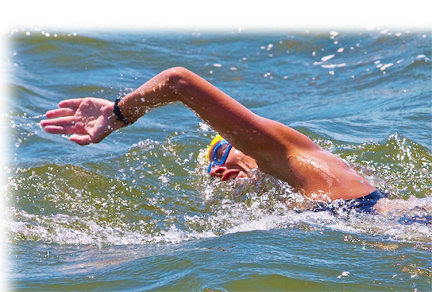Sure, you’ve heard the joke about swimming in the Hudson River: Enter with two limbs and come out with three (or a nasty bacterial infection, at the very least). In reality, the water quality is the highest it’s been in years. Would you take the plunge?
“Yes,” says Dan Shapley, Water Quality Program Manager with New York’s Riverkeeper. His organization, along with other advocacy groups like NY/NJ Baykeeper, has worked for years alongside regulatory agencies and the Clean Water Act to push for environmental responsibility and cleanup in the river. Shapley and his four-year-old son are among the estimated 7,250 people last year who swam in the Hudson. He’s quick to point out, though, that conditions have to be just right.
Progress, Not Perfection
Yes, it’s getting better. But with our population density, the parts of the river that flow past New York City and New Jersey are among the most polluted stretches of the river. “We know how to keep sewage from entering the water,” says Shapley, but outdated infrastructure on both sides of the river creates what are known as combined sewer overflows during heavy rainstorms. Our 100-year-old pipes and aging water-treatment plants get overwhelmed with sewage and storm water, which gets dumped, untreated, into the river. Fecal bacteria, not surprisingly, is a breeding ground for a host of infections, rashes, and other nasty stuff.
No Guts, No Glory
So you know to avoid the river after heavy rains. But with the possibility of sewage seeping into the water around us, why would you want to swim in the Hudson at all, particularly when the inviting waters of the Jersey Shore are just an hour’s drive away?
“The adrenaline rush, for one,” says Paul Januszewski, a Hamilton Park resident who has participated in more than five of the competitive swimming events that were organized by NYC Swim, which is no longer in operation. In its 20-year lifespan, NYC Swim attracted nearly 20,000 participants to more than 135 swimming races, reviving a local aquatic tradition that had been abandoned for nearly a century. Iconic sights like the Statue of Liberty, Manhattan, the Brooklyn Bridge, and Governors Island formed the backdrop for its premier events.
In the past five years, Januszewski has completed the Statue of Liberty Swim and twice swam the race around Governor’s Island. “You get such a high from it,” he says. “The camaraderie among the swimmers, and realizing what an exhilarating, unique experience it is. Especially if you stop in the middle of the race and take a moment to take in that view.”
An unexpected surprise, he says, was the water itself. “I was shocked by how salty it was, and when I swam, it was clear and much warmer than expected.” Any unwelcome surprises après swim, thanks to those pesky aforementioned bacteria? “Not for me,” he laughs. “And I swam without ear plugs or a wetsuit. But I know those factors change every year, depending on rain. In some years they’ve had to go ahead and cancel some of these events.”
Stick With the Group, Go With the Experts
If you’re going to test the waters, be sure to do so as part of an organized swim, says Carter Craft. A former city planner who specialized in waterfront development, Craft organized NYC Swim’s first Statue of Liberty race, back in 2009. “Organizations factor in all of the other dangers swimmers face, too,” he says. “Not only boat traffic but the changes in wave patterns caused by motorized boats. You’re also going to have a much easier time if you’re swimming with the current assisting you, not swimming against it. When planning a race, we can look at the lunar calendar to see the direction of the current, which is determined by the gravitational pull of the sun and the moon.” The Hudson River’s current can go as fast as 2.8 knots at peak ebb, as fast as people regularly walk. “You want to make sure if you get in any trouble, people are there to help you,” Craft says, reiterating that swimming alone in the Hudson—or anywhere, for that matter—is never advised.
Ready to Jump In?
Hardcore athletes like New Yorker Dimitri Konon gravitate toward the New York Triathlon; the swimming leg takes place in the Hudson. He’s done it five years running, and while he contends that the water isn’t quite pristine, the race provides an experience like no other. “I’ve done triathlons in Westchester and in the country, and there is nothing like the unique experience of swimming in the Hudson,” he says. “The crowds and the excitement just push you along, and a threat from the water is the last thing on your mind. It’s a high you can’t describe.”
Of course, with every high comes a potential low. “I’m on the ground, and at every race I’ve been at, I’ve seen a lot of swimmers come out of the water with this grime around their mouths,” says Craft. “At every organized event, you can be sure there is a hose, and trust me, every swimmer is instructed to use it thoroughly.”—JCM
Resources
The New York City Triathlon: nyctri.com
New York Riverkeeper: riverkeeper.org
NY/NJ Baykeeper: nynjbaykeeper.org
